|
They Died for Our Tomorrows
The story of a Bomber Crew
of 149 (East India) Sqdn R.A.F.
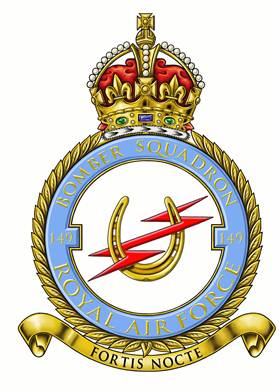
The Squadron.
As war approached, 149 (East India) Squadron was re-formed in 1937 at RAF Mildenhall as a night-bomber unit, equipped with Heyford aircraft. In early 1939 the replacement Vickers Wellingtons were received. These were sturdy, reliable aircraft which could absorb a great amount of damage. Designed by Barnes Wallis, of Dam Buster fame, the Wellington played a prominent part in the early offensive against Germany, before it was replaced by the first of the four-engine bombers. That replacement was the Short Stirling. Various constraints had turned the original design into an aircraft which was badly behaved on the ground, very manoeuvrable at low and medium altitude but sadly deficient at its operational ceiling of twelve to fifteen thousand feet. Looking a bit like a bulldog with exceptionally long legs at the front, the Stirling either was loved or hated…. Or both depending on the flight. The aircraft served 149 Sqdn right up until its withdrawal from mainstream bombing in 1944 due to unacceptable losses.
It was the same every time. Whenever they realised that their crew was on ‘Ops’ that night. That tight feeling in the stomach, the tense silence, the fear. Only stupid men did not feel that fear. These men were not stupid, although volunteers to a man. They had made the decision to serve their country by carrying the War to the Germans by air. Would it be a ‘Milk Run’ - A trip dropping mines, maybe, with a little better chance of survival. Or would it be the Ruhr, Cologne or Berlin, with the searchlights probing and the NachtJagd (Night Fighters) lurking. The briefing would tell.
Pilots and Navigators went to the first briefings ( Find a good briefing scenario)
The Crew.
F/ O. W R Booker – Captain (Pilot Killed in Action
Sgt R Franklin – Flt Engineer Killed in Action
Sgt D W B Channing – Nav Killed in Action
Sgt C D Herbert - Bomb Aimer Killed in Action
Sgt K Broadhurst - W/Op Killed in Action
Sgt C V Howden RCAF - M/Upper Gunner Killed in Action
Sgt A D Hall - Rear Gunner Killed in Action
(Sources, 149 Sqdn Operational Record Book; W R Chorley, Bomber Command Losses of the Second World War, Volume 4.)
The Aircraft.
Short Brothers Stirling Mk III, serial BK703. coded OJ-K 149 Sqdn, RAF. Built by Austen Motors. Originally issued to XV Sqdn on 2.3.43 but transferred to 149 Sqdn on 10.3.43. FTR on 28/29.6.43 from Cologne.
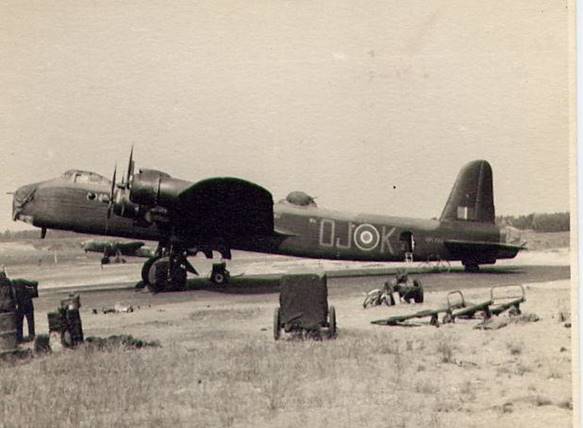
BK703 - source unknown.
The Operation.
The Squadron ORB notes, “13 Aircraft detailed to attack Cologne. Seven aircraft located the target and bombed with the aid of TIs. 10/10ths cloud up to 5.000 feet. Glow beneath clouds observed. Three aircraft returned early. Three aircraft failed to return.”
OJ-K took off from Lakenheath at 23.39. The Squadron Operational Record Book (ORB) simply states: “Aircraft failed to return to Base”. (Entry No 3).
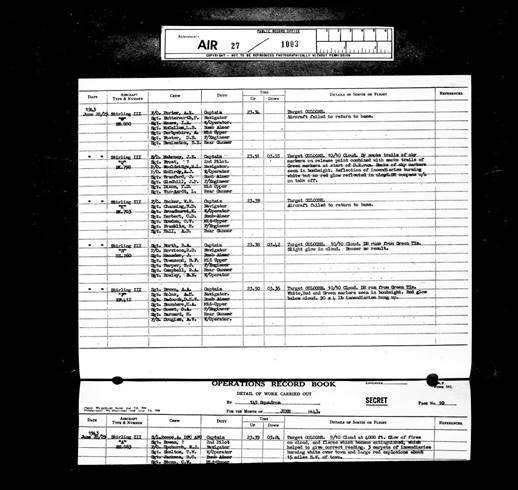
The Reason.
The aircraft was shot down and all the crew were killed. They are buried at Eindhoven (Woensel) general Cemetery. Booker and Broadhurst share one grave, Channing and Franklin share one grave and Hall and Howden share one grave. Only Sgt Herbert has a single grave.
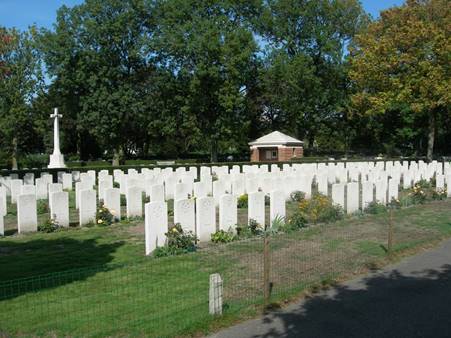
The Crew History.
Pilot F/O Booker was posted in to 149 Sqdn on 26.4.43 from 1651 HCU but did not appear to have a settled crew. For the first 3 trips they flew with different Flight Engineers, before settling on Sgt Franklin as their permanent crew member. This was not unusual at the time, as many crews had such a short lifespan. Sgt Franklin did five Operations before the crew were shot down and killed.
(Source: 149 Sqn ORBs)
Operational History.
The full “Booker” crew operational history is as follows:
1st Op - Stirling I, serial EF 360 coded OJ-R
13th May ’43 Target – Bochum
Take Off (T/O) at 23.10 from RAF Lakenheath, landing at 05.36. Sgt Scanlan was the Flt Eng on this trip. Report reads: Green TIs in bombsight. Two good fires going in the centre of TIs. Two or three Incendiaries in Port wing hung-up. Bomb doors did not open properly.
(Note: John Johnston, the author of the 149 Sqdn history, “Strong By Night”, recalls, “Incendiaries were carried in crates that reminded me of banana boxes. The crate doors open to drop the loosely packed incendiaries, with the crate remaining in the bomb bay. When they don’t (drop), the crate of incendiary bombs is brought back. Sometimes the doors open afterwards dropping the incendiaries on the closed bomb doors”.
2nd Op - Stirling III, serial BK 703 coded OJ-K
29th May ’43 Target – Wuppertal
Take Off (T/O) at 00.14 from RAF Lakenheath, landing at 03.48. Sgt Bailey was the Flt Eng on this trip. Report reads: Hazy. Cloud of smoke up to 3000ft south of target. DR run from Yellow TIs. Ground detail seen. Green TIs in bombsight. Red TIs seen to burst and change colour to white over target.
3rd Op - Stirling III, serial BK 703 coded OJ-K
11/12th Jun ’43 Target – Dusseldorf
Take Off (T/O) at 23.46 from RAF Lakenheath, landing at 03.38. Sgt Murray was the Flt Eng on this trip. Report reads: Patchy cloud at 10,000ft.. Red and Green TIs bombed at end of DR run from yellow Markers. Big fires seen on approach. Appeared North of target area.
4th Op - Stirling III, serial BK 703 coded OJ-K
19/20th Jun ’43 Target – Le Creusot
Take Off (T/O) at 22.27 from RAF Lakenheath, landing at 05.08. Sgt Franklin was the Flt Eng on this trip. Report reads: Ground mist and smoke from fire and flares at pond and railway lines. Fires in bombsight. Concentration of fires North of Pond and between Lakes. 540x 40 hung-up and brought back.
5th Op - Stirling III, serial BK 703 coded OJ-K
22/23 Jun ’43 Target – Mulheim
Take Off (T/O) at 23.49 from RAF Lakenheath, landing at 03.20. Sgt Franklin was the Flt Eng on this trip, F/O Porter was Second Pilot: Report reads: Visibility good. Ground detail obscured. TIs and DR run. Bombs dropped on centre of fires. Very good fires over area of 1 mile.
6th Op - Stirling III, serial EE872 coded OJ-N
23/24 Jun ’43 Target - West coast of France.
Take off at 22.25 from RAF Lakenheath, landing at 05.00. Report reads: Mines laid as ordered.
(Author’s note – This was my Uncle’s aircraft(N-Nuts) . Lost on 6th Sep ‘43 over Mannheim. 1 crew member survived)
7th Op - Stirling III, serial BK 703 coded OJ-K
25/26 Jun ’43 Target – Gelsenkirchen
Take Off (T/O) at 23.34 from RAF Lakenheath, landing at 03.52. Report reads:9/10ths cloud. DR run from Green flares. Markers in bombsight. Reflection of big fires in cloud. Red flares were dropping South of Green flares at 16,000ft.
8th Op - Stirling III, serial BK 703 coded OJ-K
28/29 Jun ’43 Target – Cologne
Take Off (T/O) at 23.39 from RAF Lakenheath. Report reads: Aircraft failed to return to Base.
War Diaries Entry.
608 aircraft took part in this raid. 85 Wellingtons, 267 Lancasters, 75 Stirlings, 12 Mosquitoes and 169 Halifaxes. 25 aircraft were lost - 8 Lancasters, 2 Wellingtons, 5 Stirlings and 10 Halifaxes. This was 4.1% of the force sent.
The circumstances of this raid were not promising. The weather forecast said that Cologne would probably be cloud-covered although there might be a break. The Pathfinders had to prepare a dual plan. The target was cloud-covered and the less reliable sky-marking system had to be employed. Only 7 of the 12 Oboe-equipped Mosquitoes reached the target and only 6 were able to drop their Markers. The Marking was 7 minutes late in starting and proceeded only intermittently. Despite all of these setbacks, the Main Force delivered its most powerful blow of the Battle of the Ruhr. The result was Cologne’s worst raid of the war. 43 Industrial, 6 military and 6,368 other buildings were destroyed. Nearly 15,000 other buildings were damaged. Listed as, ‘completely destroyed’ were 24 schools,16 churches, 15 major administration buildings, 11 Hotels, 8 Cinemas, 7 Post Offices, 6 large Banks, 2 Hospitals and 2 Theatres. Cologne Cathedral was seriously damaged by high-explosive bombs.
The casualties in Cologne were 4,377 people killed, approximately 10,000 injured and 230,000 forced to leave their damaged homes. The number of dead was greater than in any previous Bomber Command raid of the war on any target, so far.
(Note: All Operations notes taken from the’ Bomber Command War Diaries’ by Middlebrook and Everitt)
The Night Fighter.
The aircraft was shot down by Lt Gunter Franz of 5 Staffel 11 Gruppe / NJG 1, flying an Me 110 E operating from St. Trond, Belgium) aircraft, with (Bf Uffz. Lauer as his Bordfuncker (Radio Operator/Gunner) at 02.14 am - They claimed a Stirling over Netersel at 4600 Meters on that night. The aircraft crashed near the Dutch village of Netersel, 18miles S.W. of Eindhoven in a heath area. Recovery groups found a lot of debris from the Stirling.
Franz was operating in Raume 5B under the Zahme Sau, (Tame Pig|) tactics, which were introduced in 1943. At the indication of a forthcoming raid, the fighters were scrambled and collected together to orbit one of several radio beacons throughout Germany, ready to be directed ‘en masse’ into the bomber stream by R/T running commentaries from the Jagd division. Once fed into the stream, fighters made radar contact with a succession of individual bombers and maintained contact (and combat) as far as their ammunition and fuel held out. This resulted in a far more economic use of crews and the scoring of 'multiple' kills by the more able and experienced of the NJG 1 night fighter crews. The Franz crew was also credited with a Halifax on the same night.
( Information from Theo Boiten’s Nachtjagd War Diaries Vol I Sept '39-March '44. Page 210 - 27/8 June 1943)
Gunter Franz survived the War with eight victories to his credit.
The Aircraft.

Messerschmitt Bf 110 - picture is of a 1941 variant.
The Memorial story.
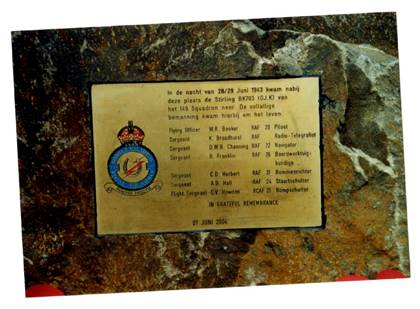
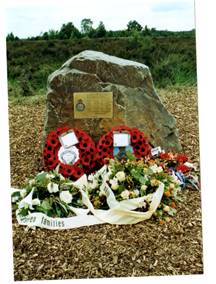
So this is the story of yet another ordinary Bomber crew, who had a short, violent history with 149 Sqdn. Our thanks go to these brave men.
There is a memorial erected to this crew in North Brabant - Netersel. The story I have yet to find……..
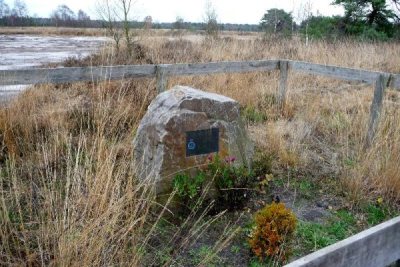
There are still many unanswered questions in this research. If anyone reading this can add, confirm or deny any information given please contact the 149 Sqn Historian; Alan Fraser.
This document has been compiled by me with the aid of many people
My thanks to them all.
Alan Fraser.
Sources:
Chorley’s BCL Vol 3.
149 Sqn ORBs
RAF Lakenheath ORBs
Kraken Luftwaffe Archives
Dr. Theo Boiten’s book, “Nachtjagd War Diaries,” Vol 1.
The Bomber Command War Diaries: by Middlebrook & Everitt
The Stirling Story, by M.J.F. Bowyers
|
 Stirling Pilott
Stirling Pilott 
 Stirling Pilott
Stirling Pilott 